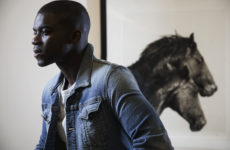Easy. That’s probably the one word that most accurately sums up Kim Jones’ fall 2017 collection for Louis Vuitton shown at the vast Parisian landmark Domaine du Palais Royal. Such an attitude is wonderful to behold but infinitely difficult to accomplish. How do you make something look effortless and comfortable in a time of such global turmoil? How much and on what levels do the clothes we cast over our bodies protect us? Not easy questions, but they kept repeating themselves in my mind as I watched a lineup of impeccably undone genius.
The undone part was helped by a thrilling collaboration with New York City-based skatewear brand Supreme. “I don’t talk about politics here, but this collection is inspired by the glory days of New York artists in the ’70s, ’80s, and ’90s—people like Keith Haring, Jean-Michel Basquiat, Andy Warhol, Julian Schnabel, Robert Mapplethorpe,” Jones told Vogue’s Sarah Mower. “It’s the time when anyone from anywhere went out and mixed together in clubs. It’s really important because that’s the thing that seems to be crumbling now.”
And maybe that speaks to the larger point–a need for belonging and togetherness, something ingrained in the international skate culture that bore Supreme. It doesn’t hurt that that same culture has an authenticity desperately missing from most of the fashion industry and produces wares designed around function and necessity. If only the rest of fashion were so astute.

Jones tapped into the very best of Supreme’s bold marketing, namely its moniker of white lettering set over a streak of deep red, on handy leather goods and went so far as to print it on indigo baseball shirts. But it wasn’t just superficial branding. There was something of a skater’s louche composure, spirit even, in the loosely draped leather trench coats, flowing trousers and perfectly oversized sweaters. They were clothes you wanted to really wear, not just collect, and enjoy for years into the future, clothes that you put on and forget about entirely until you notice someone’s eye lingering over the perfectly set sleeve of a caramel blazer or sharp proportion of an alligator bomber jacket.
His artist sartorial reference points also came through loud and clear (an overt nod to Mapplethorpe’s S&M-inspired leather caps being one example), but Jones seemed to be going after the otherness of these now famous culture shifters who were so often reviled in their own times only to be resurrected at the altar of good taste decades on. It was a call to celebrate those who think and act according to their own vision, a refusal to cast out those who would be marginalized due to the realization that they have always been the future. Their path may not be smooth, but at least their clothes don’t have to show it while giving some small comfort along the way. After all, easy is the ultimate luxury.
written by martin lerma



